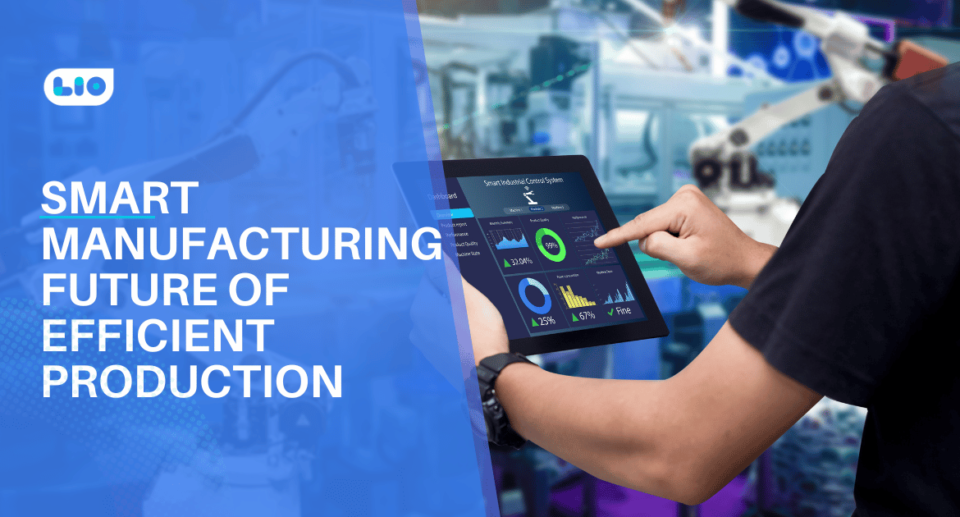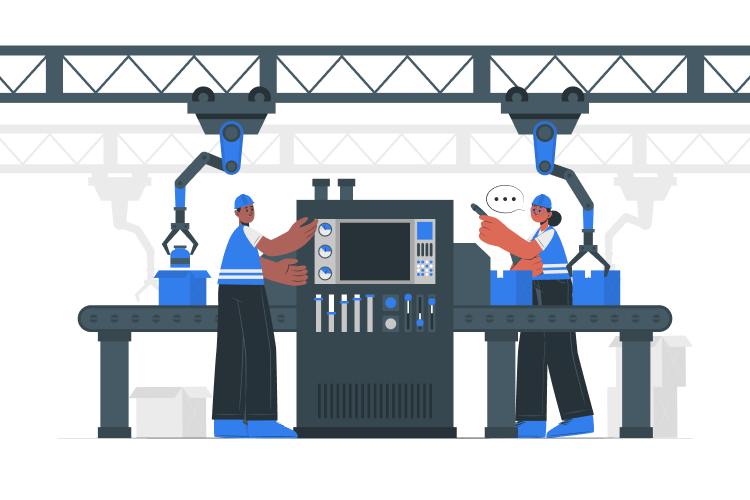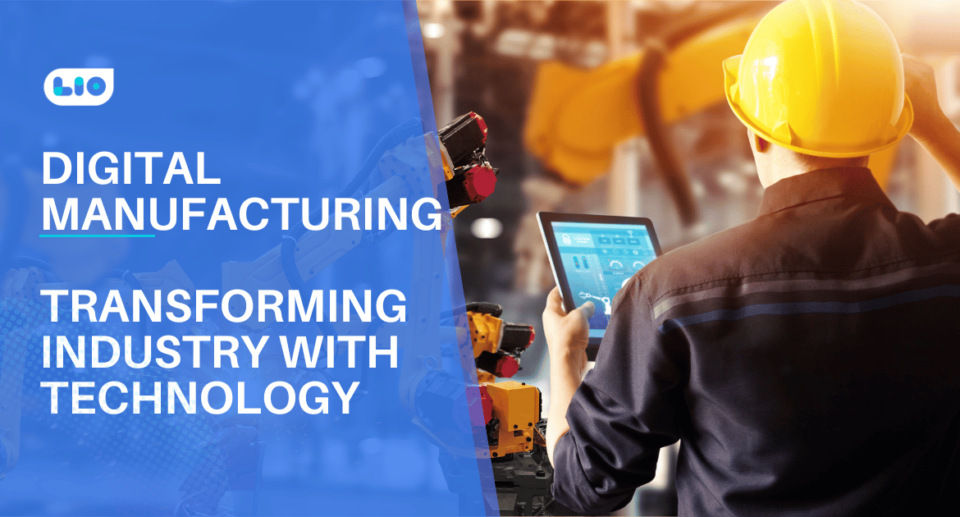Smart Manufacturing: The Future of Efficient Production
Gaurav Singh Rawat
- June 3, 2024
- 9 Min Read

Smart manufacturing is revolutionizing the way products are made by leveraging advanced technologies like the Industrial Internet of Things (IIoT), artificial intelligence, robotics, and big data analytics.
Also known as Industry 4.0, smart manufacturing aims to create intelligent, interconnected production systems that can autonomously optimize performance, adapt to changes, and enable new business models. By embedding sensors in machines and connecting them to the cloud, smart factories generate vast amounts of real-time data that can be analyzed to gain unprecedented visibility and control over every aspect of the manufacturing process.
This digital transformation promises significant benefits in terms of increased efficiency, flexibility, quality, and innovation. However, implementing smart manufacturing also poses challenges that require careful planning and execution.
What is Smart Manufacturing?
Smart manufacturing can be defined as the convergence of physical production with digital technologies to create more agile, automated, and data-driven manufacturing processes.
It involves equipping machines and systems with sensors, actuators, and connectivity to monitor, control, and optimize operations in real-time. Smart manufacturing leverages key technologies like:
- Industrial Internet of Things (IIoT) to connect and integrate machines, products, and people
- Big data analytics to gain insights from the vast amounts of data generated
- Artificial intelligence and machine learning to enable intelligent automation and decision-making
- Advanced robotics to perform complex tasks with human-like dexterity
- Additive manufacturing (3D printing) to enable mass customization
- Augmented and virtual reality for immersive training and remote collaboration
The goal is to create a self-aware, self-optimizing “smart factory” that can manufacture products more efficiently and reliably while minimizing waste and downtime.
Key Technologies Enabling Smart Manufacturing
Several advanced digital and physical technologies form the foundation of smart manufacturing:
Industrial Internet of Things (IIoT)
IIoT refers to the network of connected industrial devices, machines and systems that can exchange data. Sensors embedded in manufacturing equipment continuously stream data on operating conditions, performance, and output. This real-time visibility enables manufacturers to monitor, control and optimize processes remotely.

Boost Efficiency with IIoT
Implement Industrial Internet of Things (IIoT) solutions to enhance efficiency in your smart manufacturing ecosystem. Collect, analyze, and act on real-time data.
Big Data Analytics
Smart factories generate huge volumes of data that traditional systems cannot handle. Big data technologies like data lakes allow manufacturers to cost-effectively store and process both structured and unstructured data at scale. Advanced analytics tools help discover patterns, build predictive models, and extract actionable insights to improve decision-making.
Artificial Intelligence and Machine Learning
AI and ML give machines the ability to perceive, reason, learn and act autonomously. In manufacturing, AI enables intelligent automation of routine tasks, optimization of complex processes, and detection of anomalies and quality issues. Machine learning algorithms can continuously improve performance over time by learning from data.
Robotics and Automation
Smart manufacturing takes automation to the next level with more flexible, autonomous and collaborative robots. Advanced robotics technology with machine vision and AI enables robots to take on more complex tasks that previously required human skills. Autonomous guided vehicles and drones enable fully automated material handling and inventory management.
Additive Manufacturing (3D Printing)
3D printing technology is maturing rapidly and becoming an integral part of smart manufacturing. It enables cost-effective production of complex, customized parts and products on demand. Coupled with generative AI design tools, 3D printing will accelerate innovation and enable new manufacturing business models.

Augmented Reality and Virtual Reality
AR and VR find many applications in smart manufacturing, from product design and prototyping to immersive training and remote servicing. AR can provide workers with real-time guidance and information to improve productivity and quality. VR enables realistic simulation of products and processes to optimize design and performance.
Benefits of Smart Manufacturing
Smart manufacturing offers compelling benefits for manufacturers willing to embrace this digital transformation:
Increased Efficiency and Productivity
Real-time monitoring and automated optimization of processes can significantly increase asset utilization and production output while reducing cycle times and waste. Predictive maintenance helps maximize equipment uptime.
Improved Product Quality
Automated in-line quality inspection using computer vision and AI helps detect defects early and ensures consistent quality. The rich data collected enables continuous improvement of processes and products.

Digitize Your Production
Streamline your production processes with smart manufacturing. Leverage digital twins, simulation, and predictive maintenance to minimize downtime and improve quality.
Enhanced Flexibility and Agility
Modular, software-defined production systems can be quickly reconfigured to manufacture different products and respond faster to changing customer demands. This enables cost-effective mass customization.
Reduced Costs and Waste
Intelligent automation and optimization help reduce direct labor, inventory, material, and energy costs. Additive manufacturing and digital twins help minimize physical prototyping and testing.
Predictive Maintenance Capabilities
Analyzing real-time performance data from connected machines, manufacturers can accurately predict failures before they occur. This reduces unplanned downtime, extends asset life, and allows maintenance to be scheduled at optimal times.
Better Decision Making with Real-Time Data
The unified, real-time visibility into operations and supply chain enabled by IIoT and analytics empowers managers and workers to make faster, better-informed decisions. It also facilitates collaboration across functions and with external partners.
Challenges of Implementing Smart Manufacturing
While the benefits are significant, implementing smart manufacturing involves overcoming several challenges:
High Upfront Costs
The initial investment required for sensors, connectivity, computing infrastructure, and software can be substantial. Facilities may need expensive retrofitting. However, costs are declining rapidly as technologies mature.

Need for Skilled Workforce
Smart manufacturing requires new skills in data science, robotics, and IT. Manufacturers need to reskill current workers and attract new talent. Collaborating with universities and technology partners is crucial.
Cybersecurity Risks
The increased connectivity of machines and systems expands the attack surface for cyber threats. Robust cybersecurity measures are essential to safeguard intellectual property, operations, and products.
Integration with Legacy Systems
Most manufacturers have legacy equipment and systems that are not IoT-enabled. Integrating them with new smart manufacturing technologies can be complex and costly. A phased approach and using open standards help.
Standardization and Interoperability Issues
The lack of widely adopted standards makes it difficult for devices and systems from different vendors to interoperate seamlessly. Initiatives like the Industrial Internet Consortium are working to define common frameworks and standards.
The Future of Smart Manufacturing
As the technologies mature and adoption grows, smart manufacturing will evolve rapidly over the next decade. Some key trends that will shape the future factory include:
Emerging Trends and Technologies
We will see greater use of technologies like 5G, edge computing, blockchain, and digital twins. Manufacturers will also increasingly adopt asset-as-a-service and pay-per-use models enabled by smart manufacturing.

Empower Your Workforce
Equip your employees with smart manufacturing tools and skills. Provide augmented reality guidance, mobile apps, and data-driven insights for enhanced performance.
Potential Impact on Jobs and Workforce
While some jobs will be automated, smart manufacturing will also create many new high-skill roles. The future workforce will need to be more tech-savvy and work alongside intelligent machines. Continuous learning will be critical.
Role in Enabling Industry 4.0
Smart manufacturing is the core enabler of the fourth industrial revolution or Industry 4.0. It will pave the way for the next generation of manufacturing that is fully automated, intelligent, and integrated with the wider digital ecosystem.
Importance for Remaining Competitive
For manufacturers, adopting smart manufacturing is no longer optional – it is essential to remain competitive in the Industry 4.0 era. Early adopters will gain a significant edge in terms of operational excellence, agility, and innovation.
Conclusion
Smart manufacturing represents a transformative shift in the industry, harnessing advanced technologies like IoT, AI, robotics, and data analytics to optimize production processes.
By embracing these cutting-edge solutions, manufacturers can unlock significant benefits such as increased efficiency, improved product quality, enhanced flexibility, and reduced costs.
However, the journey towards a fully realized smart factory requires careful planning, investment in the right technologies, and a skilled workforce capable of leveraging these tools effectively.
As the manufacturing landscape continues to evolve, those who proactively adopt smart manufacturing strategies will be well-positioned to remain competitive and thrive in the Industry 4.0 era.
The future of manufacturing lies in the seamless integration of intelligent systems, data-driven decision-making, and a culture of continuous improvement. By embarking on the smart manufacturing journey today, companies can lay the foundation for a more efficient, agile, and sustainable production environment that meets the demands of tomorrow.
Frequently Asked Questions (FAQs)
What role does cybersecurity play in smart manufacturing?
Cybersecurity is critical in smart manufacturing as the increased connectivity and data sharing also introduces new vulnerabilities.
Smart factories must implement robust cybersecurity measures to protect intellectual property, operations, and products from data breaches and cyberattacks. This includes secure network architectures, encryption, access controls, and continuous monitoring for anomalies and threats.
How does smart manufacturing enable mass customization?
Smart manufacturing technologies like additive manufacturing (3D printing), advanced robotics, and flexible production lines enable cost-effective production of highly customized and configured products on a mass scale.
Digital technologies allow rapid prototyping, tooling, and production changeovers to meet individual customer requirements while still achieving economies of scale.
What role do digital twins play in smart manufacturing?
Digital twins are virtual replicas of physical assets, processes, or systems that are continuously updated with real-time data. In smart manufacturing, digital twins of machines, production lines, and entire factories allow manufacturers to monitor performance, run simulations, predict maintenance needs, and optimize processes without disrupting physical operations. Digital twins are a key enabler of the cyber-physical integration that defines Industry 4.0.
How does smart manufacturing improve supply chain visibility and agility?
Smart manufacturing technologies provide end-to-end, real-time visibility into the supply chain by connecting data across suppliers, logistics, production, and customers. This allows manufacturers to predict and respond quickly to supply disruptions, demand changes, and other variables. Advanced analytics and AI help optimize inventory, production, and distribution for maximum efficiency and agility.
What are some common challenges in implementing smart manufacturing solutions?
Some key challenges include the high upfront costs of technology and infrastructure, the need to integrate with legacy systems, a lack of standardization and interoperability between different solutions, cybersecurity risks with increased connectivity, and a shortage of skilled talent to implement and operate smart manufacturing systems. Successful adoption requires a phased approach, careful planning, and change management to address these challenges.


